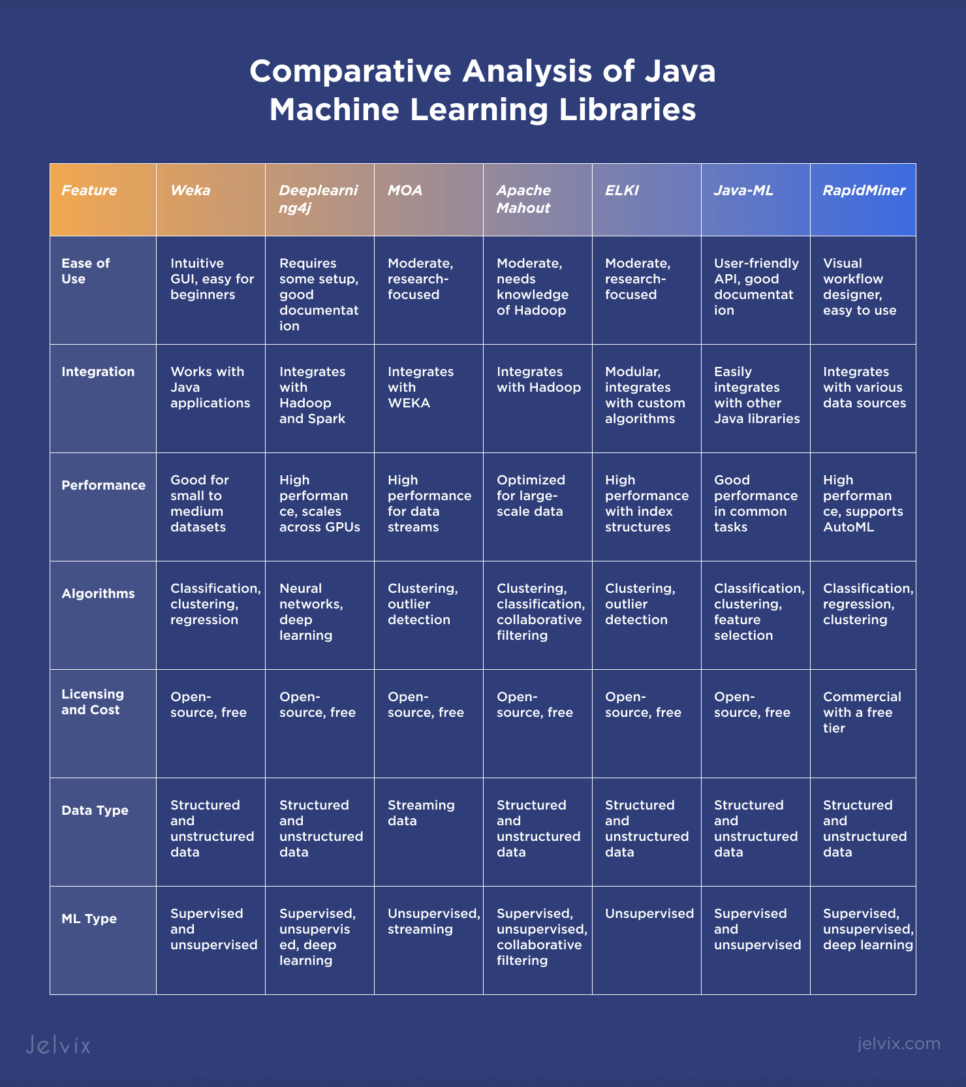Machine learning is changing the way we engage with technology, making things like tailored content suggestions and sophisticated illness detection possible. According to recent statistics, machine learning adoption is skyrocketing, with 76% of companies prioritizing over other IT initiatives. Furthermore, the global machine-learning market is expected to grow from $8.43 billion in 2019 to $117.19 billion by 2027.
Although Python is often associated with machine learning, there are situations where Java‘s abilities also make it a great option. Java provides a variety of robust libraries for creating machine-learning models. We’ll explore the eight best Java machine learning libraries, showcasing their unique features and why they stand out in this blog post.
Why Choosing the Right Java Machine Learning Libraries Is Important
Incorporating Java ML libraries into a Java-centric environment like big business apps or backend systems, can streamline integration and reduce the complications of cross-language communication. The compiled nature of Java and optimizations in JVM provide notable performance benefits, especially for applications focused on performance. Furthermore, when working with Java-based frameworks such as Spring for highly scalable applications, it is more practical to keep a consistent stack with Java ML libraries.
Java’s strong concurrency tools are advantageous for machine learning projects that need a lot of parallel processing or multithreading. Utilizing current Java code and infrastructure is typically more effective than implementing a new technology stack. Moreover, the smooth incorporation of different Java ecosystem tools like Hadoop for handling large amounts of data improves the usability of Java ML libraries.
In certain situations, the preference for Java over other languages may be driven by licensing or compliance needs. By using Java ML libraries, organizations can adhere to regulations while taking advantage of the vast features of the Java ecosystem.
When it comes to machine learning, selecting the right Java machine learning libraries can make a significant difference in the success of your projects. Here’s why.
Impact on Performance and Efficiency
Choosing the right Java library for machine learning can drastically improve the performance and productivity of your applications. Many tools for machine learning and data science can be used with Java. These tools enable efficient data processing, analysis, and visualization, vital for applying machine learning algorithms to real-world business applications and products.
One example is Apache Spark MLlib libraries created for quick and parallel data processing, perfect for big data use cases. Effective libraries decrease computational burdens, resulting in quicker training and inference durations, essential for real-time uses.
Importance for Scalability and Maintainability
Choosing the right Java machine learning library ensures your project is scalable and easy to maintain. Libraries with good documentation, modular design, and algorithm support help developers scale their applications.
For instance, Deeplearning4j integrates well with Hadoop and Spark for handling large datasets. Java’s clear structure and standard coding style ensure code consistency and ease of maintenance across large teams, which is crucial for long-term projects that require regular updates.
Relevance to Specific Project Requirements and Goals
Different machine-learning libraries fit different project types. Weka is ideal for educational purposes and prototyping with its vast collection of algorithms and user-friendly interface. MOA (Massive Online Analysis) shines in real-time big data stream mining.
Matching the library’s strengths to your project’s needs ensures you use the best tools for your specific goals, leading to more accurate models and efficient development processes. Java offers numerous data science methods like data processing, analysis, visualization, and statistical analysis, helping apply machine learning algorithms to real-world business applications.
Java’s Edge in Performance and Deployment
Java is famous for its fast performance and effectiveness. It is a language with static typing that employs Just-In-Time (JIT) compilation by default. Java translates source code to JVM bytecode, and the JIT compiler converts it into machine code for better performance during execution. Therefore, the longer a Java program operates, the more effective it gets due to ongoing optimizations conducted by the JIT compiler. This procedure guarantees quicker runtime and more effective program execution.
When it comes to releasing Java solutions, this programming language has an extra edge over others. Java developers choose it for data science applications because it delivers high performance without compromising efficiency. With Java, developers can create scalable programs with minimal code and effort. It also provides simple support for concurrent programming.
Netflix, a household name in streaming, leverages Java for its machine learning needs. Using several ML models, Netflix delivers personalized recommendations based on users’ watch history. Its ML framework combines Apache Spark, Kafka Streams, and Java to process vast amounts of data in real time. Written in pure Java, these algorithms are deployed on a cloud platform for faster training.
Things To Consider When Choosing a Library
Selecting the right Java libraries for your Java AI projects can be daunting. Here are the key factors to consider:
- Ease of Use. The library should be easy to use, especially if you’re new to machine learning. Look for clear documentation, tutorials, and a user-friendly API.
- Community Support and Documentation. Strong community support and comprehensive documentation are crucial. Libraries like Deeplearning4j have active communities and extensive documentation, which can be invaluable when troubleshooting or seeking advice.
- Integration with Other Tools and Libraries. Your chosen library should integrate well with other tools and libraries you’re using. For instance, Apache Spark MLlib works seamlessly with Hadoop and other big data tools.
- Performance and Scalability. Performance and scalability are critical, especially for large-scale applications. Libraries like Apache Spark MLlib are designed to handle big data efficiently, making them suitable for high-performance requirements.
- Lastly, consider the licensing and cost associated with the library. Open-source libraries like Weka and Deeplearning4j offer powerful features without licensing fees, which can be a significant advantage.
Picking the right Java machine learning library isn’t just about trends—it’s about finding a fit for your performance, scalability, and project goals. This smart choice will streamline development, boost model performance, and future-proof your solutions.
Top Java Machine Learning Libraries
Spark MLlib
Spark MLlib is an open-source library designed for scalable machine learning. Built on top of Apache Spark, it provides a variety of machine-learning algorithms and utilities optimized for distributed computing.
Main features include:
- Scalable Machine Learning Algorithms: Includes classification, regression, clustering, and collaborative filtering.
- Pipelines API: Simplifies creating and tuning machine learning workflows.
- Distributed Computing: Utilizes Apache Spark’s distributed computing for large-scale data processing.
- Integration: Works seamlessly with big data tools like Hadoop and Spark SQL.
- Data Handling: Provides robust data preprocessing, feature extraction, and transformation tools.
Spark MLlib provides numerous advantages to individuals utilizing Java for machine learning:
- High Performance: Optimized for speed, efficiently processing large datasets, and handling complex machine learning tasks.
- Scalability: Utilizes Apache Spark’s distributed computing, easily scaling across multiple nodes for large-scale data processing.
- Ease of Use: Provides intuitive APIs and the Pipelines API for simplified development, tuning, and deployment of machine learning workflows.
- Integration: Seamlessly integrates with Spark components like Spark SQL and Spark Streaming, and big data tools like Hadoop, facilitating smooth workflows.
Different sectors use Spark MLlib for its scalable machine learning features. In the manufacturing sector, it performs predictive maintenance and improves supply chain efficiency. Telecommunications companies utilize it for forecasting customer churn and enhancing network performance. Within the energy industry, Spark MLlib predicts energy usage and identifies issues in energy systems, showcasing its flexibility and efficiency in managing extensive data processing assignments.
Deeplearning4j
Deeplearning4j is an open-source library created for deep learning. It supports a variety of neural network architectures, including CNNs (Convolutional Neural Networks), RNNs (Recurrent Neural Networks), and LSTMs (Long Short-Term Memory Networks). Deeplearning4j integrates seamlessly with Hadoop and Spark, enabling distributed computing and scalability.
Key features include:
- Versatile Neural Network Support: Implements a wide range of neural network architectures.
- Scalability: Designed for distributed computing with Hadoop and Spark integration.
- Java and Scala APIs: Offers powerful APIs for Java and Scala developers.
- ND4J: A robust scientific computing library for efficient matrix operations.
- DataVec: A data vectorization library to preprocess and handle large datasets.
Deeplearning4j offers several key benefits for those using Java for machine learning:
- High Performance: Optimized for speed and performance, making it suitable for large-scale applications.
- Scalability: Easily scales across multiple GPUs and distributed environments.
- Flexibility: Supports a variety of neural network types and custom architectures.
- Integration: Works well with other big data tools like Hadoop and Spark, facilitating seamless integration into existing tech stacks.
In finance, Deeplearning4j helps detect fraud and manage algorithmic trading. In healthcare, it assists with predictive modeling and diagnostics. Retailers find it useful for recommendation systems and analyzing customer behavior. Meanwhile, manufacturers use it for predictive maintenance and ensuring quality control.
MOA (Massive Online Analysis)
MOA (Massive Online Analysis) is a powerful framework for data stream mining in Java ML. It focuses on handling extensive, ongoing data streams, enabling real-time analysis and machine learning. MOA offers a wide range of tools for data stream mining, such as classification, regression, clustering, outlier detection, and frequent pattern mining.
Key features include:
- Real-Time Analytics: Designed to handle data streams in real time.
- Extensive Algorithm Library: Supports a wide range of machine learning algorithms.
- Scalability: Efficiently processes large-scale data streams.
- Integration with WEKA: Can be used in conjunction with WEKA for advanced data analysis.
MOA presents a variety of perks for Java machine learning practitioners:
- Real-Time Processing: Handles continuous data streams, making it ideal for applications that require immediate insights.
- Scalability: Efficiently manages large volumes of data, ensuring high performance even with big data streams.
- Flexibility: Supports a wide range of algorithms, enabling diverse applications in various fields.
- Seamless Integration: Works well with WEKA, allowing for enhanced data analysis and model building.
MOA, or Massive Online Analysis, is used for tasks like network monitoring, fraud detection, and recommendation systems. In finance, it helps with stock market analysis and predictive analytics. Telecommunications companies use it to monitor network traffic and detect anomalies. In e-commerce, it supports customer behavior analysis and personalized marketing.
Apache Mahout
Apache Mahout is a powerful AI library for creating scalable machine-learning applications. It specializes in algorithms for clustering, classification, and collaborative filtering. Mahout is optimized for large-scale data sets and integrates seamlessly with Apache Hadoop for distributed computing.
Core features include:
- Scalable Algorithms: Designed for handling large-scale data.
- Hadoop Integration: Leverages Hadoop for distributed computing.
- Versatile Machine Learning: Supports various machine learning tasks.
- Custom Algorithm Support: Allows developers to implement custom algorithms.
- Math Library: Provides a robust math library for complex calculations.
- Support for Multiple Programming Languages: Mahout supports other JVM languages such as Scala.
Apache Mahout brings numerous benefits:
- High Performance: Optimized for speed and efficiency on large datasets.
- Scalability: Handles big data through Hadoop integration, making it suitable for extensive applications.
- Flexibility: Supports a wide range of machine learning algorithms and custom implementations.
- Community Support: Backed by a strong community for continuous improvement and support.
Apache Mahout is utilized in different sectors. In the field of online shopping, it drives recommendation systems that offer individualized product recommendations to customers. Mahout is utilized by financial institutions to identify fraud and evaluate risks. Businesses can examine customer behavior and divide audiences for tailored campaigns within the marketing industry. Social media platforms utilize Mahout to offer friend recommendations and customize content for specific users.
ELKI (Environment for Developing KDD-Applications Supported by Index-Structures)
ELKI (Environment for Developing KDD-Applications Supported by Index-Structures) focuses on unsupervised methods in cluster analysis and outlier detection. Java machine learning library is specifically designed for knowledge discovery in databases (KDD) and supports index structures to improve the efficiency of these algorithms. ELKI is highly extensible and modular, allowing researchers to develop new algorithms and compare them with existing ones.
Main features:
- Flexible infrastructure: Modular design allows seamless integration of additional algorithms and data types.
- Efficient Index Structures: Enables acceleration of clustering and outlier detection tasks by supporting index structures like R-trees and k-d trees.
- Extensive Algorithm Library: Encompasses various clustering, outlier detection, and data mining algorithms.
- Tools for visualizing: Offers capabilities for exploring data and interpreting results through visualization.
- Benchmarking: Allows researchers to benchmark and evaluate the performance of different algorithms.
Java developers can gain several benefits by using ELKI:
- Flexibility: Modular design allows easy integration of new algorithms and index structures.
- Performance: Index structures enhance clustering and outlier detection efficiency.
- Research-Oriented: Ideal for academic purposes due to its extensive algorithm library and benchmarking tools.
- Visualization: Tools for visualizing data sets and results aid in better understanding and interpretation.
ELKI is widely used in academic research and industry for tasks requiring robust cluster analysis and outlier detection. It’s ideal for fraud detection, network security, and market analysis. Researchers use ELKI to develop and test new algorithms, leveraging its flexible framework. In industry, ELKI helps identify unusual patterns in large datasets, such as detecting fraudulent transactions or network traffic anomalies.
Java-ML
Java-ML is designed specifically for Java developers. It provides a rich collection of machine learning algorithms that are easy to use and integrate into Java applications. Java-ML focuses on simplicity and flexibility, making it an excellent choice for beginners and advanced users who need a robust toolkit for various machine-learning tasks.
Highlighted features:
- Extensive Algorithm Library: Includes algorithms for classification, clustering, feature selection, and data preprocessing.
- Modular Design: Users can easily add or modify algorithms.
- User-Friendly API: Straightforward API for implementing machine learning models.
- Integration Capabilities: Seamlessly integrates with other Java libraries and frameworks.
- Documentation and Examples: Comprehensive documentation and example codes for a quick start.
Key Benefits:
- Simplicity: User-friendly API and clear documentation make it accessible for all levels of developers.
- Flexibility: Modular design allows customization and extension to meet specific needs.
- Comprehensive: Offers a variety of machine learning algorithms for common tasks.
- Integration: Easily integrates with other Java tools and frameworks.
Java-ML is used in finance for credit scoring and risk assessment models, healthcare for predictive analytics and diagnostics, and marketing for customer segmentation and behavior analysis. It also supports educational purposes, providing a practical tool for teaching machine learning concepts.
RapidMiner
RapidMiner is designed to support the entire lifecycle of data science projects. It offers tools for data preparation, machine learning, deep learning, text mining, and predictive analytics. RapidMiner provides a powerful visual workflow designer to create and deploy machine learning models without extensive programming knowledge.
Core features:
- Visual Workflow Designer: Drag-and-drop interface for building complex models and workflows.
- Wide Range of Algorithms: Supports a variety of machine learning algorithms for classification, regression, clustering, and more.
- Integration Capabilities: Seamlessly integrates with various data sources, including databases, cloud storage, and enterprise applications.
- Automated Machine Learning (AutoML): Simplifies the model-building process by automating feature engineering, model selection, and hyperparameter tuning.
- Extensibility: Offers plugins and extensions to enhance functionality and integrate with other tools.
Using Rapidminer can be beneficial because of:
- Ease of Use: The visual workflow designer makes it accessible for users with limited programming skills.
- Comprehensive Toolset: Covers all aspects of data science projects, from data preparation to model deployment.
- Integration: Easily connects to multiple data sources, enhancing its versatility.
- Automation: AutoML capabilities speed up the model-building process and improve productivity.
- Community and Support: Backed by a strong community and extensive documentation.
RapidMiner finds its way into many industries due to its powerful capabilities. In finance, it helps with risk assessment, fraud detection, and customer segmentation. Healthcare professionals use it for predictive analytics, patient diagnostics, and treatment recommendations. It’s useful in retail for market basket analysis, demand forecasting, and predicting customer churn. Manufacturers rely on it for predictive maintenance and quality control, while marketers use it to optimize campaigns and analyze customer behavior.
Weka
Weka (Waikato Environment for Knowledge Analysis) is a popular AI library designed for data mining and machine learning tasks. It provides a range of machine learning algorithms for tasks like data pre-processing, classification, regression, clustering, association rules, and visualization.
Key features of Weka include:
- Preprocessing Tools: Clean and prepare your data with filters.
- Machine Learning Algorithms: Implement classification, regression, clustering, and more.
- Visualization: Visualize data and model results effectively.
- User Interface: Easy-to-use graphical user interface (GUI).
- Java API: Weka provides a powerful Java API for those who prefer coding.
Weka stands out among deep learning libraries because of its ease of use and extensive algorithm selection. Here are some key benefits:
- Ease of Use: Weka’s GUI makes experimenting with different algorithms without writing code easy.
- Comprehensive Documentation: Extensive guides and tutorials help users quickly get up to speed.
- Versatility: Suitable for both educational purposes and real-world data mining tasks.
- Integration: Can be integrated into Java applications using its API, making it versatile for various projects.
Weka is widely used in various fields for different purposes. In education, it is ideal for teaching machine learning concepts due to its simplicity. Researchers frequently use Weka in academic settings to test new algorithms. It is also popular for prototyping, allowing developers to quickly create machine learning models before deploying them in production. In industry, Weka is employed for data mining tasks such as customer segmentation, fraud detection, and predictive maintenance.
Choosing the right machine learning framework can significantly impact your project’s success. Consider factors like ease of use, community support, integration capabilities, performance, scalability, and cost. By carefully evaluating these aspects, you can select a library that best fits your needs and enhances your machine-learning projects.
Comparative Analysis of Java Machine Learning Libraries
How Do Famous Companies Use Java Machine Learning?
These Java programming examples showcase how leading companies leverage Java for machine learning to enhance their services. Here are specific projects and their benefits.
- LinkedIn uses Java for machine learning projects like its job recommendation engine. This system uses Hadoop and Java to analyze user profiles and suggest relevant job opportunities.
- Twitter employs Java and Scala for spam detection and content filtering. These models identify and filter spammy content, ensuring a cleaner platform.
- Spotify uses Java and Apache Spark for its music recommendation system, analyzing user habits to suggest personalized playlists.
- Uber utilizes Java for predictive analytics, dynamic pricing, and fraud detection. Java’s integration with big data tools helps Uber process and analyze vast amounts of data efficiently.
- PayPal employs Java for real-time fraud detection and risk management, analyzing transaction data to prevent fraudulent activities.
- IBM uses Java in machine learning projects like IBM Watson’s cognitive services, providing natural language processing and data analytics.
- Pinterest leverages Java for image recognition and recommendation algorithms, suggesting relevant pins and boards to users.
These companies use Java for machine learning to enhance efficiency and user experience, scale their solutions, and enable real-time processing. Java’s robust performance, scalability, and cross-platform support make it ideal for handling large datasets and deploying solutions across various platforms.
Let’s take a look at machine learning applications in multiple industries, from digital businesses to industries that are still transforming, to understand the benefits of this technology.
Conclusion
Java machine learning libraries excel in performance, scalability, and cross-platform support. For Java deep learning projects, Deeplearning4j offers robust neural network capabilities, while RapidMiner provides user-friendly workflows. Weka is ideal for educational purposes, and Apache Mahout and MOA are perfect for handling big data and streaming analytics. Each library has its unique strengths, tailored to different use cases. For expert guidance and the latest insights on Java machine learning libraries, reach out to the Jelvix team. Contact us today to get started!
FAQ
What is machine learning and why is it important?
Machine learning is a subset of artificial intelligence that enables systems to learn and make decisions from data. It is important because it allows for automation, predictive analytics, and intelligent decision-making in various industries, enhancing efficiency and innovation.
Why should I use Java for machine learning?
Java is a popular programming language known for its portability, scalability, and robust ecosystem. It has strong community support, numerous libraries, and tools specifically designed for machine learning, making it a viable choice for both beginners and advanced practitioners.
How do I choose the right Java machine learning library?
Evaluate the specific needs of your project, such as the type of data, required algorithms, and performance requirements. Consider the library’s ease of use, documentation, community support, and compatibility with your existing systems. Also, assess the scalability, performance, and licensing costs to ensure the library aligns with your long-term goals.
What is the role of deep learning in Java?
Deep learning in Java, facilitated by libraries such as Deeplearning4j, plays a crucial role in enabling complex neural network architectures and large-scale data processing. It allows for the development of advanced AI applications such as image and speech recognition, natural language processing, and predictive analytics.
How long does it take, on average, to build an ML solution using Java?
The time required to build an ML solution using Java varies depending on the complexity of the project, the size of the dataset, and the specific requirements. Utilizing robust libraries and tools can help streamline the development process.
Need a certain developer?
Use our top talent pool to get your business to the next level.













